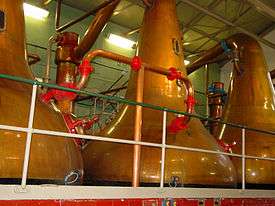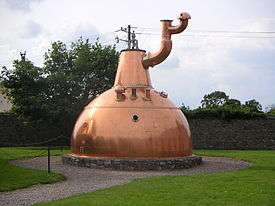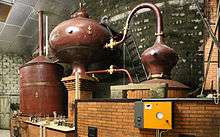Pot still
A pot still is a type of distillation apparatus or still used to distill flavored liquors such as whisky or cognac, but not rectified spirit because they are bad at separating congeners. Pot stills operate on a batch distillation basis (as opposed to a Coffey or column stills which operate on a continuous basis). Traditionally constructed from copper, pot stills are made in a range of shapes and sizes depending on the quantity and style of spirit desired.

Spirits distilled in pots top out between 60 and 80 percent ABV (after multiple distillations).
By law, cognac, Irish and Scotch malt whiskies, and single pot still whiskey must be distilled using a pot still.[1][2][3]
Method of operation
During first distillation, the pot still (or "wash still") is filled about two-thirds full of a fermented liquid (or wash) with an alcohol content of about 7–12%.[4][5][6] In the case of whiskey distillation, the liquid used is a beer, while in the case of brandy production, it is a base wine. The pot still is then heated so that the liquid boils.
The liquid being distilled is a mixture of mainly water and alcohol, along with smaller amounts of other by-products of fermentation (called congeners), such as aldehydes and esters.[5] Alcohol (ethanol) has a normal boiling point of 78.4 °C (173.12 °F), compared with pure water, which boils at 100 °C (212 °F).[7] As alcohol has a lower boiling point, it is more volatile and evaporates at a higher rate than water. Hence the concentration of alcohol in the vapour phase above the liquid is higher than in the liquid itself.
During distillation, this vapour travels up the swan neck at the top of the pot still and down the lyne arm, after which it travels through the condenser, where it is cooled to yield a distillate with a higher concentration of alcohol than the original liquid.[5] This distillate, called "low wines" has a concentration of about 25–35% alcohol by volume.
These low wines can be further distilled a second time in a pot still to yield a distillate with a higher concentration of alcohol.[6] In the case of many Irish whiskeys, the spirit is further distilled a third time. However, cognac and most single malt scotch whiskies are only distilled twice.
During distillation, the initial and final portions of spirit which condense (termed the heads and tails respectively) may be captured separately from that in the centre or "heart" of the distillation. This is because these portions of the distillate may contain high concentrations of methanol (which is toxic), or other congeners (which it may be desirable to keep out of the final distillate for reasons of style or taste).
History
The modern pot still is a descendant of the alembic, an earlier distillation device.

The largest pot still ever used was located in the Old Midleton Distillery, County Cork, Ireland.[8][9] Constructed in 1825, it had a capacity of 143,740 litres (31,618 imp gal) and is no longer in use. As of 2014 the largest pot stills in use are coincidentally located in the neighbouring New Midleton Distillery, County Cork, Ireland, and have a capacity of 75,000 L (16,000 imp gal).[10]
Components of a traditional pot still:[7]
- Pot – where the wash is heated
- Swan Neck – where the vapours rise and reflux
- Lyne Arm – transfers the vapour to the condenser
- Condenser – cools the vapour to yield distillate
 A Cognac pot still
A Cognac pot still- A spirit safe (i.e. padlocked apparatus at the end of the pot still enabling the distiller to cut off the "heads" and "tails" of distillation; it is padlocked for excise reasons)
References
- "Technical file setting out the specifications with which Irish whiskey / Uisce Beatha Eireannach / Irish Whisky must comply" (PDF). www.agriculture.gov.ie. Department of Agriculture, Forestry and Marine. October 2014. Archived from the original (PDF) on 18 October 2016. Retrieved 28 December 2016.
- The Scotch Whisky Regulations 2009, The National Archives, 2009.
- "L'encyclopédie du Cognac: Different distillation methods". Bureau National Interprofessionnel du Cognac Entreprise. Retrieved 24 January 2017.
- "Characteristics of the Wine". L’encyclopédie du Cognac. Bureau National Interprofessionnel du Cognac Entreprise. Retrieved 22 January 2017.
- O'Connor, Fionnán (2015). A Glass Apart: Single Pot Still Whiskey. Victoria, Australia: Images Publishing. p. 33. ISBN 1864705493.
- Whisky: Technology, Production and Marketing. Elsevier. 2014. pp. 10–12. ISBN 0124046037.
- The Art of Distilling Whiskey and Other Spirits. Quarry Books. 2011. ISBN 1616735554.
- Cooley, Arnold James (1880). Cooley's cyclopædia of Practical Receipts and Collateral Information in the Arts, Manufactures, Professions, and Trades. J. & A. Churchill. p. 1767.
Here, I believe, is the largest still in the world—certainly the largest in Ireland.
- Dublin, Cork, and south of Ireland: a literary, commercial, and social review. Stratten & Stratten. 1892. p. 157.
Midleton Distillery.
- "€200m expansion project helps Midleton to brew up a storm". Engineers Journal (Engineers Ireland). 2014.
External links
| Wikimedia Commons has media related to Pot stills. |